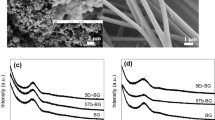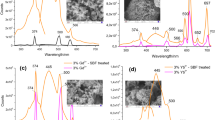Abstract
In this study, sol–gel-based erbium (Er3+), terbium (Tb3+) and Er3+: Tb3 co-doped 1393 bioactive glass powders and electrospun nanofibers were prepared. Structural and morphological properties of the bioactive glasses as well as the photoluminescence characteristics were investigated in detail. The median particle size and average diameter of the prepared glass powders and fibers were in the range of ~ 1.5–3.5 μm and 280–660 nm, respectively. The steady-state photoluminescence and decay kinetics of the samples were investigated under excitation (374 nm) where only Er3+ and Tb3+ ions close to Si nanoclusters can be excited. All the samples prepared in the study exhibited bright green emission upon excitation at 374 nm. Results showed that the dopant concentration and the sample morphology have significant influence on the photoluminescence and decay properties of the glasses. Sol–gel-derived bioactive glass particles exhibited stronger emission intensity, whereas electrospun nanofibers showed extended decay times. In vitro bioactivity experiments revealed that Er3+ and Tb3+ doping did not inhibit the conversion of the glass samples to hydroxyapatite treated in simulated body fluid for 30 days. It was concluded that Er3+ and Tb3+-containing 1393 bioactive glasses have a potential to be used in tissue engineering applications as well as bioimaging studies.














Similar content being viewed by others
References
Lu H, Chen F, Xi P, Chen B, Huang L, Cheng J, Shao C, Wang J, Bai D, Zeng Z (2011) Biocompatible fluorescent hydroxyapatite: synthesis and live cell imaging applications. J Phys Chem C 115:18538–18544. https://doi.org/10.1021/jp206843w
Neacsu IA, Stoica AE, Vasile BS, Andronescu E (2019) Luminescent hydroxyapatite doped with rare earth elements for biomedical applications. Nanomaterials 9(2):239. https://doi.org/10.3390/nano9020239
Grabmaier BC (1994) Luminescent materials for medical application. J Lumin 60–61:967–970. https://doi.org/10.3390/nano9020239
Gerhard L-C, Boccaccini AR (2010) Bioactive glass and glass-ceramic scaffolds for bone tissue engineering. Materials 3:3867–3910. https://doi.org/10.3390/ma3073867
Hench LL, Splinter RJ, Allen WC, Greenlee TK Jr (1971) Bonding mechanisms at the interface of ceramic prosthetic materials. J Biomed Mater Res 2:117–141. https://doi.org/10.1002/jbm.820050611
Hench LL, Wilson J (1984) Surface active biomaterials. Science 226:630–636. https://doi.org/10.1126/science.6093253
Rahaman MN, Day DE, Bal BS, Fu Q, Jung SB, Bonewald LF, Tomsia AP (2011) Bioactive glass in tissue engineering. Acta Biomater 7(6):2355–2373. https://doi.org/10.1016/j.actbio.2011.03.016
Brink M, Turunen T, Happonen R, Yli-Urpo A (1997) Compositional dependence of bioactivity of glasses in the system Na2O-K2O-MgO-CaO-B2O3-P2O5-SiO2. J Mater Sci Mater Med 37:114–121. https://doi.org/10.1002/(sici)1097-4636(199710)37:1<114::aid-jbm14>3.0.co;2-g
Fan Y, Yang P, Huang S, Jiang J, Lian H, Lin J (2009) Luminescent and mesoporous europium-doped bioactive glasses (MBG) as a drug carrier. Phys Chem C 113(18):7826–7830. https://doi.org/10.1021/jp900515x
Li G, Liang G, Zhao S, Ma K, Feng W, Zhou D, Liu X (2014) Synthesis and characterization of porous luminescent glass ceramic scaffolds containing europium for bone tissue engineering. Adv Appl Ceram. 114(3):164–174. https://doi.org/10.1179/1743676114Y.000000021
Saarinen M, Nommeots-Nomm A, Hokka M, Laurila J, Norrbod I, Lastusaarid M, Massera J, Petit L (2018) Persistent luminescent particles containing bioactive glasses: Prospect toward tracking in-vivo implant mineralization using biophotonic ceramics. J Eur Ceram Soc 38:287–295. https://doi.org/10.1016/j.jeurceramsoc.2017.08.024
Ganjali MR, Gupta KV, Faridbod GF, Norouzi P (2016) Lanthanides series determination by various analytical methods. Chapter 2, Applications of the lanthanide series in human life. pp 37–58. https://doi.org/10.1016/B978-0-12-804704-0.00002-5
Patnaik P (2002) Handbook of inorganic chemicals. McGraw-Hill
Alshemary AZ, Akram M, Goh Y-F, Abdul Kadir MR, Abdolahi A, Hussain R (2015) Structural characterization, optical properties and in vitro bioactivity of mesoporous erbium-doped hydroxyapatite. J Alloys Compd 645:478–486. https://doi.org/10.1016/j.jallcom.2015.05.064
Pham V-H, Van HN, Tam PD, Ha HNT (2016) A novel 1540 nm light emission from erbium doped hydroxyapatite/-tricalcium phosphate through co-precipitation method. Mater Lett 167:145–147. https://doi.org/10.1016/j.matlet.2016.01.002
Mondal S, Nguyen VT, Park S, Choi J, Tran LH, Yi M, Shin JH, Lee C-Y, Oh J (2020) Bioactive, luminescent erbium-doped hydroxyapatite nanocrystals for biomedical applications. Ceram Int 46(10):16020–16031. https://doi.org/10.1016/j.ceramint.2020.03.152
Li Q, Xing M, Chen Z, Wang X, Zhao C, Qiu J, Jianding Yu, Chang J (2016) Er3+/Yb3+ co-doped bioactive glasses with up-conversion luminescence prepared by containerless processing. Ceram Int 42(11):13168–13175. https://doi.org/10.1016/j.ceramint.2016.05.108
Hammond CR (2000) The elements in handbook of chemistry and physics. CRC Press
Wang X, Zhang Y, Lin C, Zhong W (2017) Sol-gel derived terbium-containing mesoporous bioactive glasses nanospheres: in vitro hydroxyapatite formation and drug delivery. Colloids Surf B 160:406–415. https://doi.org/10.1016/j.colsurfb.2017.09.051
Qiao Y, Li Y-X, Yin H-R, Liu P, Li S-Y, Zhang P (2015) Preparation and luminescent properties of terbium-doped hydroxyapatite. Chin J Lumin 36(1):63-68. https://doi.org/10.3788/fgxb20153601.0063
Deliormanlı AM, Yıldırım M (2016) Sol-gel synthesis of 13–93 bioactive glass powders containing therapeutic agents. J Aust Ceram Soc 52(2):9–19
Deliormanlı AM (2015) Preparation in vitro mineralization and osteoblast cell response of 13–93 bioactive glass nanofibers for biomedical applications. Mater Sci Eng C Mater Biol Appl 53:262–271. https://doi.org/10.1016/j.msec.2015.04.037
Kokubo T, Kushitani H, Sakka S, Kitsugi T, Yamamuro T (1990) Solutions able to reproduce in vivo surface-structure change in bioactive glass-ceramic A-W. J Biomed Mater Res 24:721–734. https://doi.org/10.1002/jbm.820240607
Silva AMB, Queiroz CM, Agathopoulos S, Correia RN, Fernandes MHV, Oliveira JM (2011) Structure of SiO2–MgO–Na2O glasses by FTIR, Raman and 29Si MAS NMR. J Mol Struct 986:16–21. https://doi.org/10.1016/j.molstruc.2010.11.023
Wong J, Angell CA (1976) Glass structure by spectroscopy. Marcel Dekker, New York
Nariyal RK, Kothari P, Bisht B (2014) FTIR measurements of SiO2 glass prepared by sol-gel technique. Chem Sci Trans 3(3):1064–1066. https://doi.org/10.7598/cst2014.816
Nakamoto K (1997) Infrared and raman spectra of inorganic and coordination compounds: part A—theory and applications in inorganic chemistry, 5th edn. Wiley, New York
Carter CB, Norton MG (2013) Ceramic materials: science and engineering. Complex crystal and glass structures (Chap. 7). Springer, pp 103–122. https://doi.org/10.1007/978-1-4614-3523-5_7
Xu GQ, Zheng ZX, Tang WM, Wu YC (2007) Multi-peak behavior of photoluminescence of silica particles heat-treated in hydrogen at elevated temperature. J Lumin 126:43–47. https://doi.org/10.1016/j.jlumin.2006.05.001
Ehrt D, Ebeling P (2003) Radiation defects in borosilicate glasses. Glass Technol 44(2):46–49
de Dood MJA, Slooff LH, Polman A, Moroz A, van Blaaderen A (2001) Modified spontaneous emission in erbium-doped SiO2 spherical colloids. Appl Phys Lett 79(22):3585–3587. https://doi.org/10.1063/1.1419033
Said Mahraz ZA, Sahar MR, Ghoshal SK, Reza Dousti M (2013) Concentration dependent luminescence quenching of Er3+-doped zinc boro-tellurite glass. J Lumin 144:139–145. https://doi.org/10.1016/j.jlumin.2013.06.050
Lo Savio R, Miritello M, Cardile P, Priolo F (2009) Concentration dependence of the Er3+ visible and infrared luminescence in Y2-xErxO3 thin films on Si. J Appl Phys 106:043512. https://doi.org/10.1063/1.3195077
Ehrt D (2011) Photoactive glasses and glass ceramics. IOP Conf Ser Mater Sci Eng 21:012001
Wojdak M, Jayatilleka H, Shah M, Kenyon AJ, Gourbilleau F, Rizk R (2013) Modification of erbium photoluminescence decay rate due to ITO layers on thin films of SiO2: Er doped with Si-nanoclusters. J Lumin 136:407–410. https://doi.org/10.1016/j.jlumin.2012.11.042
Sun XY, Huang SM, Gu M, Gao QC, Gong XS, Ye ZP (2010) Enhanced Tb3+ luminescence by non–radiative energy transfer from Gd3+ in silicate glass. Phys B 405:569–572. https://doi.org/10.1016/j.physb.2009.09.067
Sun XY, Yu XG, Wang WF, Li YN, Zhang ZJ, Zhao JT (2013) Luminescent properties of Tb3+–activated B2O3–GeO2–Gd2O3 scintillating glasses. J Non-Cryst Solids 379:127–130. https://doi.org/10.1016/j.jnoncrysol.2013.08.002
Sun XY, Jiang DG, Wang WF, Cao CY, Li YN, Zhen GT, Wang H, Yang XX, Chen HH, Zhang ZJ, Zhao JT (2013) Luminescence properties of B2O3–GeO2–Gd2O3 scintillating glass doped with rare-earth and transition-metal ions. Nucl Inst Methods Phys Res A 716:90–95. https://doi.org/10.1016/j.nima.2013.03.036
Kik PG, Polman A (2001) Exciton–erbium energy transfer in Si nanocrystal-doped SiO2. Mater Sci Eng B 81(1–3):3–8. https://doi.org/10.1016/S0921-5107(00)00667-X
Bei J, Qian G, Liang X, Yuan S, Yang Y, Chen G (2007) Optical properties of Ce3+-doped oxide glasses and correlations with optical basicity. Mater Res Bull 42:1195–1200. https://doi.org/10.1016/j.materresbull.2006.10.020
Yao Y, Liu L, Zhang Y, Chen D, Fang Y, Zhao G (2016) Optical properties of Ce3+ doped fluorophosphates scintillation glasses. Opt Mater 51:94–97. https://doi.org/10.1016/j.optmat.2015.11.026
Lisitsyn VM, Valiev DT, Tupitsyna IA, Polisadova EF, Oleshko VI, Lisitsyna LA, Andryuschenko LA, Yakubovskaya AG, Vovk OM (2014) Effect of particle size and morphology on the properties of luminescence in ZnWO4. J Lumin 153:130–135. https://doi.org/10.1016/j.jlumin.2014.03.024
Silver J, Martinez-Rubio MI, Ireland TG, Fern GR, Withnall R (2001) The effect of particle morphology and crystallite size on the upconversion luminescence properties of erbium and ytterbium co-doped yttrium oxide phosphors. J Phys Chem B 105(5):948–953. https://doi.org/10.1021/jp002778c
Kim Y, Kang S (2011) Effect of particle size on photoluminescence emission intensity in ZnO. Acta Mater 59(8):3024–3031. https://doi.org/10.1016/j.actamat.2011.01.042
Kislyuk V, Strilchuk G, Lozovski V, Osipyonok M, Lytvyn P (2004) Influence of particle size on luminescence spectra. Progr Colloid Polym Sci 125:24–26. https://doi.org/10.1007/978-3-540-45119-8_4
Berezin MY, Achilefu S (2010) Fluorescence lifetime measurements and biological imaging. Chem Rev 110(5):2641–2684. https://doi.org/10.1021/cr900343z
Jain A, Blum C, Subramaniam V (2009) Advances in biomedical engineering, Chapter 4, Fluorescence lifetime spectroscopy and imaging of visible fluorescent proteins. pp 147–176. https://doi.org/10.1016/B978-0-444-53075-2.00004-6
Larrañaga A, Ramos D, Amestoy H, Zuza E, Sarasua J-R (2015) Coating of bioactive glass particles with mussel-inspired polydopamine as a strategy to improve the thermal stability of poly(L-lactide)/bioactive glass composites. RSC Adv 5:65618–65626. https://doi.org/10.1039/C5RA09495J
Miola M, Verné E, Ciraldo FE, Cordero-Arias L, Boccaccini AR (2015) Electrophoretic deposition of chitosan/45S5 bioactive glass composite coatings doped with Zn and Sr. Front Bioeng Biotechnol 3:159. https://doi.org/10.3389/fbioe.2015.00159
Acknowledgements
The financial support of The Scientific and Technological Research Council of Turkey (TUBITAK), Grant No: 119M934, is gratefully acknowledged. Photoluminescence characterizations were performed at Dokuz Eylul University, Center for Production and Applications of Electronic Materials (EMUM). The SEM and XRD analysis were performed at Manisa Celal Bayar University—Applied Science and Research Center (DEFAM).
Author information
Authors and Affiliations
Corresponding author
Ethics declarations
Conflict of interest
The authors declare that they have no conflict of interest.
Additional information
Handling Editor: Joshua Tong.
Publisher's Note
Springer Nature remains neutral with regard to jurisdictional claims in published maps and institutional affiliations.
Supplementary Information
Below is the link to the electronic supplementary material.
Rights and permissions
About this article
Cite this article
Deliormanlı, A.M., Rahman, B., Oguzlar, S. et al. Structural and luminescent properties of Er3+ and Tb3+-doped sol–gel-based bioactive glass powders and electrospun nanofibers. J Mater Sci 56, 14487–14504 (2021). https://doi.org/10.1007/s10853-021-06203-7
Received:
Accepted:
Published:
Issue Date:
DOI: https://doi.org/10.1007/s10853-021-06203-7




